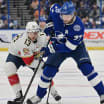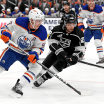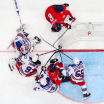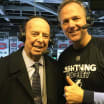Hellebuyck's new training routine key to early success with Jets
Goalie focused on body mechanics to change his game
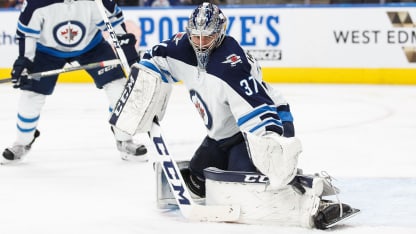
© Codie McLachlan/Getty Images
Instead, Maurice talked about Hellebucyk's stance and his ability to hold it.
"He looked stronger in the net," Maurice said about the first of three straight starts for Hellebuyck. "He was] able to hold his body position quite a bit longer; not nearly as much movement in his game."
***[RELATED: [Holtby fondly remembers singer from The Tragically Hip | More Unmasked stories]*
It was an oddly specific reference, especially for a coach not in charge of goalies.
It was also an accurate, if simplified, description of Hellebuyck's focus during an offseason in which he partly rebuilt his game by completely changing how he trained to play it.
Hellebuyck, who is 3-0-0 with a .211 goals-against average and a .937 save percentage entering a home game against the Minnesota Wild on Friday (8 p.m. ET; TSN3, FS-N+, NHL.TV), is battling Steve Mason for the No. 1 job early in the season.
The changes for Hellebucyk began shortly after he switched to agent Ray Petkau of Alpha Hockey Inc. and was introduced to its director of development, Adam Francilia, whose clients include goalies James Reimer of the Florida Panthers, Thomas Greiss of the New York Islanders, Laurent Brossoit of the Edmonton Oilers, Eddie Lack of the Calgary Flames and Devan Dubnyk of the Minnesota Wild.
Hellebucyk and Francilia started together in June with workouts via FaceTime, which Francilia uses with Europe-based clients in the offseason. Hellebuyck also twice flew to Kelowna, British Columbia, for a week of hands-on workouts.
Whether online in the gym or in person on the ice, the workouts were all new to the 24-year-old goalie.
"A complete 180 [degree turnaround] from what I was doing before," Hellebuyck said. "I was lifting a bunch of weights but now I actually feel in control of my body and I have a base for it because he preaches core and everything out from there. So, now, I truly feel like my core is stabilizing the rest of my game."
Focusing on core strength is common, but don't confuse the work Hellebuyck put in during the offseason with articles in health magazines about getting a six-pack stomach. His workouts focused on teaching the brain and body to activate specific muscles, including the obliques, in the correct sequence for more efficient movement on the ice, eliminating the counterrotation of legs moving in one direction while the upper body and arms swing the other way, much like a speedskater.
The training is specific to goalies.
"In fact, there are many instances where we are actually training a goalie's brain and nervous system to not do what we would train another athlete to do," said Francilia, who also works with Jets defenseman Tyler Myers, Pittsburgh Penguins defenseman Justin Schultz and Islanders forward Andrew Ladd. "If we are training a sprint athlete or a skater we are trying to focus on rotational explosiveness and initiation of rotation for a lot of what we do. With a goalie, we are actually training [counter] to what is nature because goalie is such an unnatural position. It's so different, not just different than a Men's Health train-your-core kind of thing, but the biomechanics are actually different than a regular sports-performance mentality."
Those correct biomechanics show up in the stability Maurice pointed to after Hellebuyck made 37 saves on 39 shots in that first win, at the Edmonton Oilers on Oct. 9. He flails his arms less, and there are fewer sequences that end with him on his stomach or butt. His movements are more balanced, compact and controlled, helping him arrive set and square in each new save location earlier, rather than getting his feet to that new spot and having to wait for the rest of his body to catch up.
It sounds simple, but it wasn't a snap-your-fingers process for Hellebuyck (6-foot-4, 207 pounds).
"He's such a big guy with long legs and arms and he was extremity-based in his movements," Francilia said. "You could see the movement was from the outside in, not the inside out. His sequencing wasn't proper, so his responses didn't line up with what was needed from the play or movement pattern. It was a lot of reprogramming for him to get dialed in and feel connected."
Workouts that incorporated everything from resistance bands on the ice to the Eldoa method, a technique developed by a French osteopath to create space and balance throughout the body, helped develop and strengthen that connection before speed was introduced.
"It would be like adding 50 horsepower to a drag-race car, but the lug-nuts aren't on properly; it's going to go faster but it's also going to come apart at that speed," Francilia said. "If I just added speed, his body would have come apart."
By August, Hellebuyck could feel the difference.
"Every summer before I've gotten myself bagged, just run down," he said. "But this year I finally feel like I am taking the next step in control of my energy levels and being in shape to a next level and I can still skate as much as I want to."
